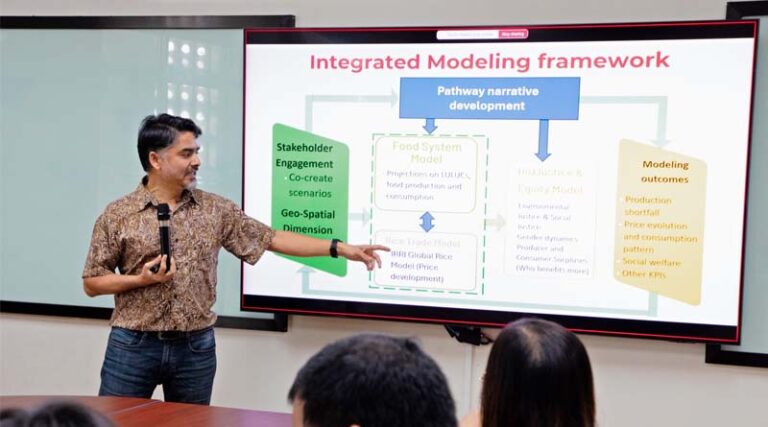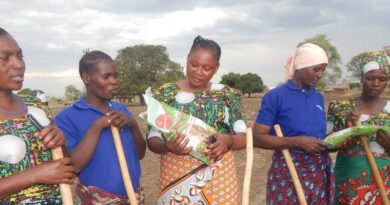
Fastforward: IRRI Model Scenarios Peek Into The Future of PH Rice Self-sufficiency In 2050
10 October 2025, Philippines: In a recent seminar by the International Rice Research Institute (IRRI), IRRI Scientist Dr. Shyam Basnet shared how linking food, agriculture, biodiversity, land use, and energy systems can simulate different pathways to the Philippines’ rice future by 2050.
In his talk, “Pathways to Achieving Rice Self-Sufficiency in the Philippines: Balancing Food Security and the Environment,” Dr. Basnet highlighted that the country could fill in the rice gap through higher farm productivity with modest shifts toward less rice-heavy diets and lower food waste.
Through scenario modeling, researchers can anticipate several plausible futures by adjusting key drivers, such as diets, yields, trade, and climate.
“If you follow all the government pathways, such as diet and farm productivity, then what does it mean in terms of the environment, like having sufficient land? That’s the main question I was trying to address,” Dr. Basnet said.
Drawing recent data from the Food and Agriculture Organization (FAO), Philippine Statistics Authority (PSA), and other scientific sources, Dr. Basnet mentioned that as of 2022, Filipinos’ diet remain rice-heavy, with rice and rice-based products accounting for about 72% of their cereal consumption. Sugar intake is above the recommended level by the Department of Science and Technology-Food and Nutrition Research Institute (DOST-FNRI), while milk, legumes, fruits, vegetables, and fats and oils are under-consumed, pointing to the need for healthier, more diverse plates.
Rice imports were about 7.2% of consumption in 2000 and have climbed to nearly 14% today. By contrast, the country was largely self-sufficient in the 1980s, when population and per-capita rice consumption were lower. Dr. Basnet cautioned that meeting today’s larger demand through land expansion alone would entail significant environmental costs. In 2022, the Philippine’s Department of Agriculture reported 77% rice self-sufficiency.
Dr. Basnet introduced an Excel-based tool under ongoing development, which can generate various scenarios by linking demand (population, incomes, and animal feed needs) with other variables (yields, trade, land, and climate impacts). Using this, he was able to project some plausible scenarios for different pathways:
- Business-as-usual path: Imports will remain at around 15% under current diets and productivity levels, requiring little additional cropland but resulting in minimal progress toward self-sufficiency.
- National target path: Imports will be reduced to 2.6% while following national diet recommendations and productivity targets. Although this pathway would achieve the government’s self-sufficiency goal, it would require extensive new cropland, increasing risks to biodiversity and greenhouse gas emissions.
- Ambitious path: Imports will also be reduced to 2.6%, but with healthier, slightly less rice-heavy diets and higher productivity. This scenario would lower land use, reduce greenhouse gas emissions and water demand, and bring the country closer to achieving full self-sufficiency.
Dr. Basnet also added that further work is underway to enhance the integrated modelling framework by incorporating the market module of IRRI’s in-house economic model—the IRRI Global Rice Model (IGRM). This will help assess how these scenarios could affect future rice prices and expand the model to build a bigger picture of the rice sector.
“I think we have very good assets in IRRI to understand how different actors in the food systems will affect not only justice and equity (including environmental concerns, social justice, gender dynamics, and distribution of producer and consumer surpluses), but also the commodity market (e.g. rice market) and everything connected to it,” he said.
Also Read: CropLife India Re-Elects Ankur Aggarwal as Chairman at 45th AGM
📢 If You’re in Agriculture, Make Sure the Right People Hear Your Story.
From product launches to strategic announcements, Global Agriculture offers unmatched visibility across international agri-business markets. Connect with us at pr@global-agriculture.com to explore editorial and advertising opportunities that reach the right audience, worldwide.






